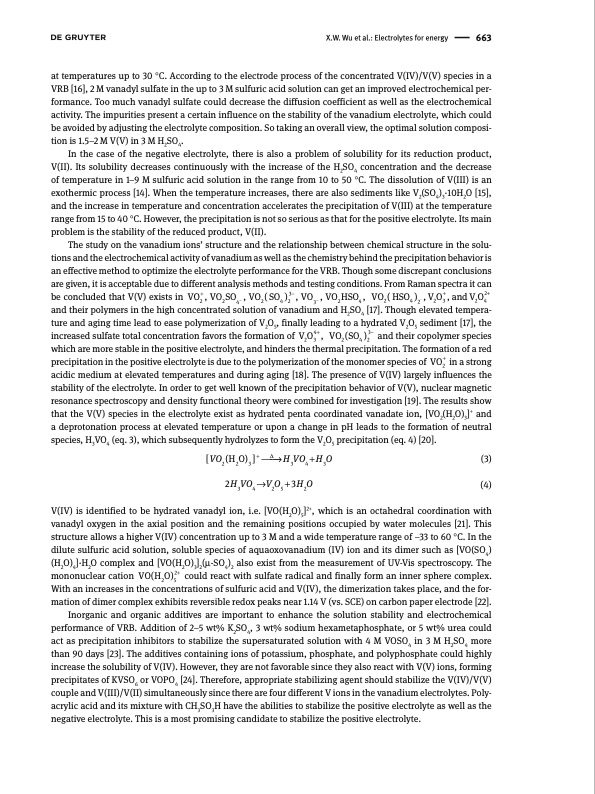
PDF Publication Title:
Text from PDF Page: 003
beconcludedthatV(V)existsinVO+,VOSO ,VO(SO)3−,VO ,VOHSO, VO(HSO) ,VO+,andVO2+ 2 2 4− 2 42 3− 2 4 2 42- 23 24 and their polymers in the high concentrated solution of vanadium and H2SO4 [17]. Though elevated tempera- ture and aging time lead to ease polymerization of V2O5, finally leading to a hydrated V2O5 sediment [17], the increased sulfate total concentration favors the formation of V O4+ , VO (SO )3− and their copolymer species 23242 which are more stable in the positive electrolyte, and hinders the thermal precipitation. The formation of a red precipitationinthepositiveelectrolyteisduetothepolymerizationofthemonomerspeciesofVO+ inastrong 2 acidic medium at elevated temperatures and during aging [18]. The presence of V(IV) largely influences the stability of the electrolyte. In order to get well known of the precipitation behavior of V(V), nuclear magnetic resonance spectroscopy and density functional theory were combined for investigation [19]. The results show that the V(V) species in the electrolyte exist as hydrated penta coordinated vanadate ion, [VO2(H2O)3]+ and a deprotonation process at elevated temperature or upon a change in pH leads to the formation of neutral species, H3VO4 (eq. 3), which subsequently hydrolyzes to form the V2O5 precipitation (eq. 4) [20]. X.W. Wu et al.: Electrolytes for energy 663 at temperatures up to 30 °C. According to the electrode process of the concentrated V(IV)/V(V) species in a VRB [16], 2 M vanadyl sulfate in the up to 3 M sulfuric acid solution can get an improved electrochemical per- formance. Too much vanadyl sulfate could decrease the diffusion coefficient as well as the electrochemical activity. The impurities present a certain influence on the stability of the vanadium electrolyte, which could be avoided by adjusting the electrolyte composition. So taking an overall view, the optimal solution composi- tion is 1.5–2 M V(V) in 3 M H2SO4. In the case of the negative electrolyte, there is also a problem of solubility for its reduction product, V(II). Its solubility decreases continuously with the increase of the H2SO4 concentration and the decrease of temperature in 1–9 M sulfuric acid solution in the range from 10 to 50 °C. The dissolution of V(III) is an exothermic process [14]. When the temperature increases, there are also sediments like V2(SO4)3·10H2O [15], and the increase in temperature and concentration accelerates the precipitation of V(III) at the temperature range from 15 to 40 °C. However, the precipitation is not so serious as that for the positive electrolyte. Its main problem is the stability of the reduced product, V(II). The study on the vanadium ions’ structure and the relationship between chemical structure in the solu- tions and the electrochemical activity of vanadium as well as the chemistry behind the precipitation behavior is an effective method to optimize the electrolyte performance for the VRB. Though some discrepant conclusions are given, it is acceptable due to different analysis methods and testing conditions. From Raman spectra it can +∆ [VO(HO)] →HVO+HO (3) 223 343 2H3VO4 →V2O5 +3H2O (4) V(IV) is identified to be hydrated vanadyl ion, i.e. [VO(H2O)5]2+, which is an octahedral coordination with vanadyl oxygen in the axial position and the remaining positions occupied by water molecules [21]. This structure allows a higher V(IV) concentration up to 3 M and a wide temperature range of –33 to 60 °C. In the dilute sulfuric acid solution, soluble species of aquaoxovanadium (IV) ion and its dimer such as [VO(SO4) (H2O)4]·H2O complex and [VO(H2O)3]2(μ-SO4)2 also exist from the measurement of UV-Vis spectroscopy. The With an increases in the concentrations of sulfuric acid and V(IV), the dimerization takes place, and the for- mation of dimer complex exhibits reversible redox peaks near 1.14 V (vs. SCE) on carbon paper electrode [22]. Inorganic and organic additives are important to enhance the solution stability and electrochemical performance of VRB. Addition of 2–5 wt% K2SO4, 3 wt% sodium hexametaphosphate, or 5 wt% urea could act as precipitation inhibitors to stabilize the supersaturated solution with 4 M VOSO4 in 3 M H2SO4 more than 90 days [23]. The additives containing ions of potassium, phosphate, and polyphosphate could highly increase the solubility of V(IV). However, they are not favorable since they also react with V(V) ions, forming precipitates of KVSO6 or VOPO4 [24]. Therefore, appropriate stabilizing agent should stabilize the V(IV)/V(V) couple and V(III)/V(II) simultaneously since there are four different V ions in the vanadium electrolytes. Poly- acrylic acid and its mixture with CH3SO3H have the abilities to stabilize the positive electrolyte as well as the negative electrolyte. This is a most promising candidate to stabilize the positive electrolyte. mononuclear cation VO(H O)2+ could react with sulfate radical and finally form an inner sphere complex. 25PDF Image | Electrolytes for vanadium redox flow batteries

PDF Search Title:
Electrolytes for vanadium redox flow batteriesOriginal File Name Searched:
10-1515_pac-2013-1213.pdfDIY PDF Search: Google It | Yahoo | Bing
Salgenx Redox Flow Battery Technology: Salt water flow battery technology with low cost and great energy density that can be used for power storage and thermal storage. Let us de-risk your production using our license. Our aqueous flow battery is less cost than Tesla Megapack and available faster. Redox flow battery. No membrane needed like with Vanadium, or Bromine. Salgenx flow battery
| CONTACT TEL: 608-238-6001 Email: greg@salgenx.com | RSS | AMP |